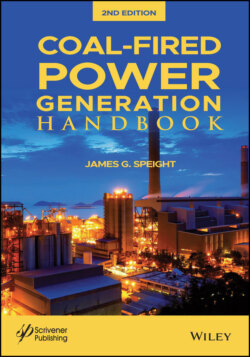Читать книгу Coal-Fired Power Generation Handbook - James Speight G., James G. Speight - Страница 23
1.6.1 Proven Reserves
ОглавлениеThe proven reserves for any commodity should provide a reasonably accurate estimate of the amount that can be recovered under existing operating and economic conditions. To be economically mineable, a coal seam (coalbed, also called a coalbed, hence coal bed methane) bed must have a minimum thickness (approximately 2 feet) and be buried less than some maximum depth (approximately 6,600 feet) below the surface of the Earth. These values of thickness and depth are not fixed but change with criteria such as (i) coal quality, (ii) coal demand, (iii) the ease with which overlying rocks can be removed for surface mining or a shaft sunk to reach the coal seam for underground mining. The development of new mining techniques may increase the amount of coal that can be extracted relative to the amount that cannot be removed. For example, in underground mining, which accounts for approximately 60% w/w of world coal production, conventional mining (pillar mining) methods leave behind large pillars of coal to support the overlying rocks and recover only about half of the coal present. On the other hand, longwall mining, in which the equipment removes continuous parallel bands of coal, may recover almost all the coal present in the seam.
Table 1.7 Estimated Coal Reserves by Country (Energy information Administration, 2011).
| Coal | |
| United States | 27.5% |
| Russia | 18.3% |
| 1. China | 13.3% |
| Other Non-OECD Europe and Eurasia | 10.7% |
| Australia and New Zealand | 8.9% |
| India | 7.0% |
| OECD Europe | 6.5% |
| Africa | 3.7% |
| Other Central and South America | 0.9% |
| Rest of World | 3.2% |
| Total | 100.0% |
Source: US Energy Information Administration, International Energy Outlook, September 2011.
Figure 1.4 Energy Resources of the Earth (Speight, 2013).
Figure 1.5 Resource and reserve terminology (Speight, 2013).
In addition, an issue which concerns the estimation of reserves, is the rate at which the coal is consumed. When considering the worldwide reserves of coal, the number of years that coal will be available may be more important than the total amount of coal resources. For example, the coal reserves may be estimated using the current rates of consumption, which may indicate that the world coal reserves should last more than 300 to 500 years. However, a large amount of additional coal is present in Earth but cannot be recovered using current technology and these resources, sometimes called geologic resources, are even more difficult to estimate, but may be much greater than the amount of proven reserves.
Thus, in the current context, the proven reserves (proved reserves) are those coal reserves that are actually found (proven), usually by drilling and coring. The estimates have a high degree of accuracy and are frequently updated as the mining operations proceed. However, even though the coal reserves may be proven, there is also the need to define the resources on the basis of what further amount of coal might be recoverable (using currently available mining technology without assuming, often with a very high degree of optimism) extravagantly, that new technology will miraculously appear or will be invented) and non-recoverable coal reserves will suddenly become recoverable.
If economic aspects are not considered, the term for the total technologically extractable amount of coal is the producible fraction, which is often confused with the proven reserves. The term proven reserves is further subdivided into proved developed reserves and proved undeveloped reserves. This should not be confused with unproven reserves, which are broken down into probable reserves and possible reserves – those reserves that only have a 10% likelihood of being recoverable.
These reserve categories can, as in the crude oil industry (Speight, 2011b, 2014), be cumulatively summed by the measures 1P, 2P, and 3P, which are inclusive, so include the previous safer measures as (i) 1P reserves – proven reserves consisting of both proved developed reserves plus proved undeveloped reserves), (ii) 2P reserves – consisting of 1P proven reserves plus probable reserves, and (iii) 3P reserves – consisting of the sum of 2P reserves plus possible reserves.
On the other hand, the estimated ultimate recovery of coal (or any resource) is the sum of the proven reserves at a specific time and the cumulative production up to that time.
